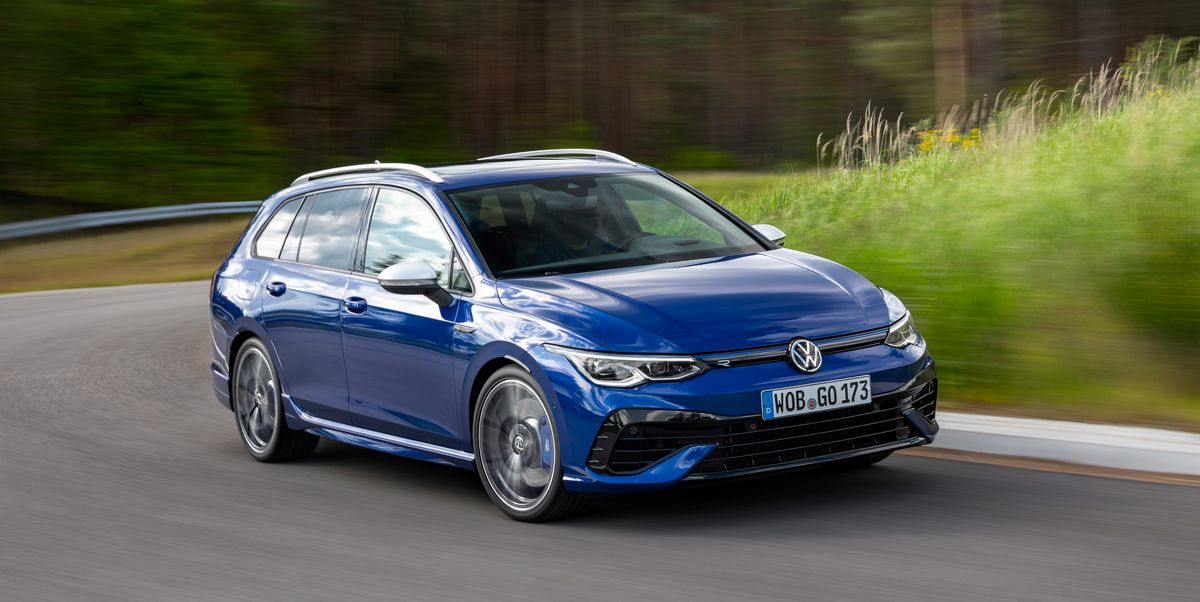Volkswagen Golf R Wagon: Europe's Gain Is Our Loss

Many things in Europe are inferior to what’s in the United States. Showers are generally weak and ineffectual, hotel room air conditioning a cruel hoax, and the size of both restaurant portions and parking spaces often measly. But there are areas where Europeans enjoy clear advantages, including the ability to choose cars such the Volkswagen Golf R wagon.
While Europe has many SUVs, it hasn’t given up on station wagons. So, although the Volkswagen T-Roc R offers the same powertrain in a slightly taller package, buyers are also able to select the Golf R in this intriguing longroof form. And isn’t this a more elegant and practical solution than yet another crossover?
After driving one in the U.K., it’s genuinely hard to think of a better-rounded all-rounder than a 315-hp all-wheel-drive Golf wagon. With an unlimited budget, you might be inclined to nominate the Audi RS6 Avant instead. Alas, most folks don’t have bottomless pockets, and the VW is considerably less than half the price in Europe.
From the front end to B-pillars, the Golf R wagon is unsurprisingly similar to its hatchback sibling. Behind that, it gets a longer rear door thanks to a 1.9-inch wheelbase stretch, but it’s at the back that the biggest and most obvious changes have happened. Overall length has increased by a substantial 13.9 inches to 182.8 inches. The wagon’s cargo hold is about 60 percent roomier, which equates to eight more cubic feet of volume with the rear seats in place. Weight has gone up too, with the R Wagon’s roughly 3600-pound curb weight making it about 240 pounds heavier than the hatch.
The extra mass means the Golf R wagon is slower than the hatchback—which laid down a 3:04.3 time at Lightning Lap—but not to an egregious degree. The 5200 rpm at which the turbocharged engine starts to deliver its full 315 horses is only rarely reached under even rapid road use, whereas the maximum 310 pound-feet of torque will be experienced regularly given that it’s present from just 2100 rpm. The seven-speed DSG transmission shuffles its ratios both speedily and deftly when acceleration is called for, and although it is possible to shift manually using the steering-wheel paddles, there never seemed to be much point in doing so, and the shifters themselves are plastic and feel insubstantial.
The rest of the dynamic experience also feels better adapted to highway than byway. The R wagon’s steering is accurate, and the car has a sense of high-speed stability that feels as if it would be well suited to an unrestricted autobahn. Cruising refinement is good, too, with 100 mph seeming no louder than 80 mph should be. Yet although the R’s variable-ratio steering is precise at lower speeds, it offers little natural feedback, with the more aggressive Sport and Race drive modes adding extra resistance without any increase in sensation.
Chassis settings are pliant to the point of sometimes feeling soft. Our car was equipped with the adaptive dampers, which are an extra-cost option in Europe. They offer no fewer than 15 configurations available in Individual mode, but even in their firmest setting the R still had lots of vertical movement over larger bumps. The wagon has clearly been designed to be driven hard while loaded; it rode noticeably better with four occupants and around 100 pounds of luggage aboard.
Like the hatchback, the R wagon has a torque-biasing rear differential intended to sharpen cornering response, and European buyers can even pay extra to add a Drift mode—a compellingly ludicrous option that our car didn’t have. The diff adds its assistance subtly, sending torque to the outside rear wheel to help the car to turn in tighter corners but without ever creating the aggressive, tip-in sensation of the last Ford Focus RS’s active system. It makes for high-speed, low-effort progress. This car is quick and relaxing as opposed to a machine that delivers frequent adrenaline highs.
As with other versions of the eighth-generation Golf, the interior is slightly underwhelming. We loved the R’s blue plaid cloth seats and the good range of driving position adjustment. We were less keen on both the fussy user interface and the touchscreen, which is hard to operate without inadvertently brushing the touch-sensitive ledge beneath that controls temperature and audio volume. The digitally augmented engine note that is piped into the cabin also seemed to be trying to reproduce a five-cylinder soundtrack, strangely—maybe it’s harking back to the inline-five version of the fourth-generation Golf that Volkswagen once offered (again only in Europe). Although the wheelbase stretch provides a slight increase in legroom for rear seat passengers, it is still tight in back for adult passengers.
In a parallel universe, one where the crossover either hadn’t been invented or had been hunted to extinction, the Golf R wagon might work well in the States. Or, indeed, anywhere that people want to combine performance, practicality, and personality. The longroof feels more grown-up than the hatchback and would be easier to live with or to put more stuff into. Its absence is our loss.
A car-lover’s community for ultimate access & unrivaled experiences. JOIN NOW
This content is created and maintained by a third party, and imported onto this page to help users provide their email addresses. You may be able to find more information about this and similar content at piano.io



